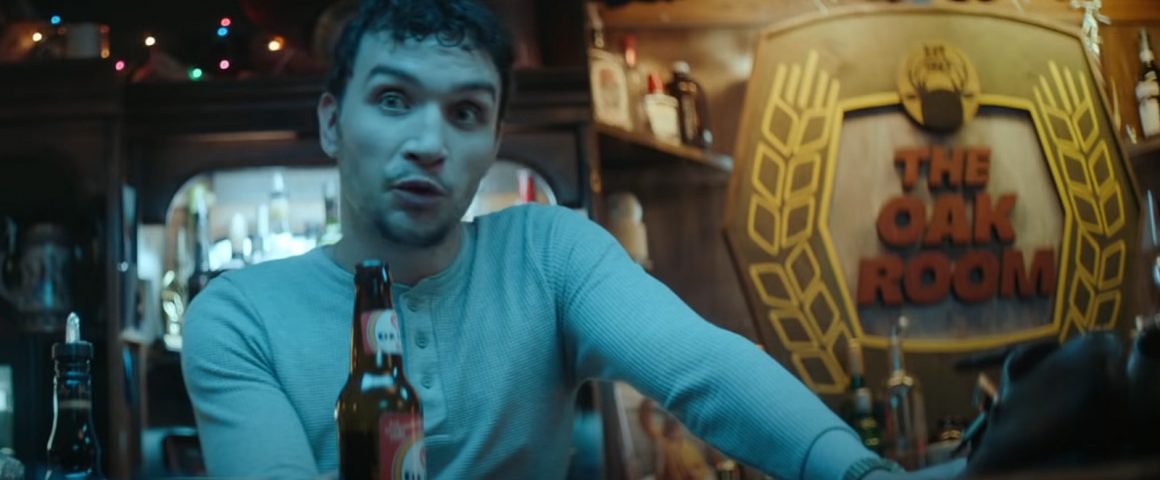A single environment further enclosed by the forces of winter has proved a suspenseful setting for many a film. From “The Shining” to “The Thing” to “The Hateful Eight,” filmmakers have taken advantage of isolation and inhospitable conditions to create scenarios that breed mistrust, paranoia and outright aggression. Some incorporate a wider expanse into their confinement, while others embrace the restrictions.
The Oak Room is one of the latter, a low budget chamber piece where the action takes place almost entirely in two bars. Director Cody Calahan uses these restrictions to impressive effect, as the audience can both start to feel comfortable in the space, just as they feel uncomfortable with the events that unfold. Furthermore, Peter Genoway’s script gives us a series of nested narratives, with characters telling stories, in some cases about characters telling stories. From the opening titles consisting of aerial shots over a snowy landscape, we move inside the Pool Room, a blue-collar bar in a small town somewhere in Canada. Bartender Paul (Peter Outerbridge, “Giant Little Ones”) is closing up when young man Steve (RJ Mitte, “Time Share”) returns after three years of absence. Less than pleased to see him, Paul demands that Steve pay debts both to him and others, debts that Steve attempts to settle through a story. This story takes us to another bar, the eponymous Oak Room, where we meet, variously, Michael (Ari Millen, “Beast Within”), Richard (Martin Roach, “The Shape of Water”) and Kenneth (David Ferry, “The Boondock Saints II: All Saints Day”). Steve’s story comes in fragments, including a story by Michael that is itself in fragments, and we learn that Steve heard this story from Thomas (Amos Crawley, “Kill Order”). We flash back to the Pool Room where Paul tells Steve a couple of stories, along with some storytelling tips. Thus, we have multiple narrators, and Paul’s recommendations about fabrications prompt us to question which, if any, are reliable.
This narrative approach captures the viewer’s attention much as it does Paul’s, with recurring motifs and steady withholding as well as reassessments of information, all of which create suspense and tantalization. Each of the stories are gripping in their own right, but they also prompt considerations of where the narrative might be going next. Do these stories connect? Why do we get the middle, end and beginning out of order? And is there a reason that each teller narrates this tale to a particular listener?
Calahan reveals details with careful editing and smart use of the cinematic space, cinematographer Jeff Maher steeping the bars in deep shadow punctuated with islands of light. Justin Reu’s production design ensures that the bars feel well used and well cared for, thus creating a palatable sense of place and community. You can believe in these isolated towns with their singular bars where everyone comes to drink and chat, because the Pool Room and the Oak Room are places where everybody knows your name.
Not that these bars are like “Cheers.” Both are dingy and sparsely inhabited, and familiarity seem more likely to breed contempt rather than camaraderie. The drinking is more to forget than to reminisce, a point underscored by the story told by Steve’s father Gordon (Nicholas Campbell, “Backcountry”), within a story told by Paul, of course, where he describes his life as a long, pointless slog through hell. Furthermore, Paul may speak fondly of Gordon, but he is more likely to curse Steve’s name as well as handling the drunken Thomas. Richard, Kenneth and Michael engage in banter, but the dialogue steadily devolves into suspicion and even violence.
While used sparingly, when violence occurs it is shocking and effectively nasty, more likely to induce winces than relieve tension. A shift in editing jars the viewer’s sensibilities, giving us both the visceral thrill of the attacker and the anguished pain of the victim, especially during a gruesome if largely offscreen dismemberment. The inescapable pain is made more apparent by the claustrophobic environment and the relentless blizzard outside, our lack of knowledge over the real events made more palatable by the certainty that there is nowhere better to go.
The blizzard serves a mood as well as narrative device, for an overall sense of cold permeates the bars and also the thematic substance of The Oak Room. Two of the stories told take place in other locations but offer no comfort or respite, one on a road with a malevolent unseen motorist, the other on a wintry night where a boy encountered death. Each of these stories are harrowing in their own right and contribute to an overall chill factor as an insidious sense of dread creeps through the film like frostbite seeping through the inadequate shoes of someone who did not expect to break down in a blizzard. Come the final ominous shot, you may now understand what has taken place, but there is only cold comfort to be found in this claustrophobic and gripping tale of tales and recriminations.



